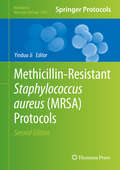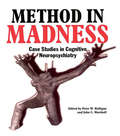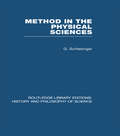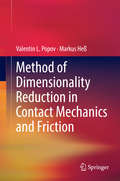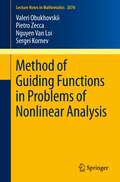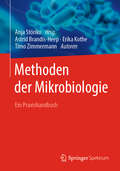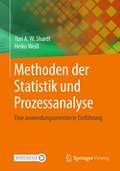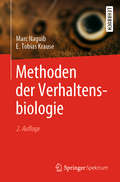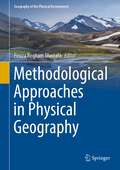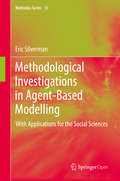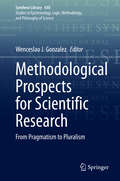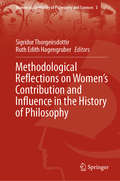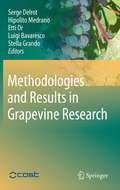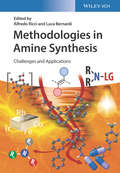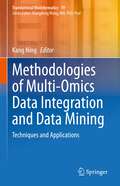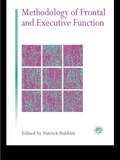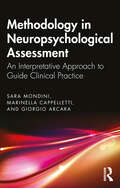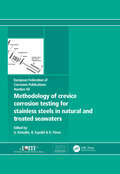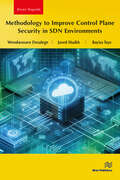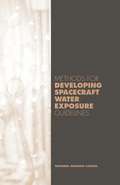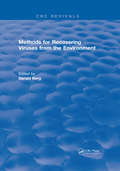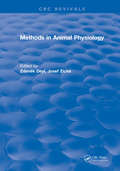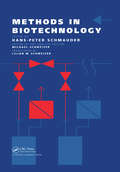- Table View
- List View
Methicillin-Resistant Staphylococcus aureus (MRSA) Protocols
by Yinduo JiThis book provides a comprehensive collection of the most up-to-date techniques for the detection and investigation of MRSA. Each chapter begins with a brief introduction to the method and purpose, and then goes into detailed protocols for every step of analysis. Several chapters also include a section with tips not usually found in methods books. These tips may represent the difference between immediate success and lengthy troubleshooting.
Method In Madness: Case Studies In Cognitive Neuropsychiatry
by John C. Marshall Peter W. HalliganIn clinical neuropsychiatry, case studies provide invaluable demonstrations of the range and types of unusual psychological states that can occur after brain damage. In the pursuit of objectivity and scientific respectability, however, many academic reports of neuropsychiatric disorders appear cold, contrived and impersonal. The essence and character of the patient's experience and behaviour is easily obscured or even lost - a fact that cannot help researchers, therapists and other practitioners to relate their conceptual knowledge to the flesh-and-blood people they meet in their professional lives. In practice, much of the actual discourse of such patients has been ignored as unworthy of scientific interest. This book describes real patients in a clear and jargon-free way. These cases should serve to reduce the discrepancy between the formal representations of psychiatric illness in the mainstream literature and the reality of people struggling to make sense of their own predicament in everyday life.
Method in the Physical Sciences (Routledge Library Editions: History & Philosophy of Science)
by G SchlesingerOriginally published in 1963. Can one discern certain regularities in the manoeuvrings and techniques employed by scientists and can these be formulated into the methodological principles of science? What is the origin and basis of such principles? Are they imposed by objective realities, do they derive from conceptual necessities or are they rooted in our own deep seated predilections? This volume investigates these questions and sheds light on the growth mechanism of the evolving structure of science itself.
Method of Dimensionality Reduction in Contact Mechanics and Friction
by Valentin L. Popov Markus HeßThis book describes for the first time a simulation method for the fast calculation of contact properties and friction between rough surfaces in a complete form. In contrast to existing simulation methods, the method of dimensionality reduction (MDR) is based on the exact mapping of various types of three-dimensional contact problems onto contacts of one-dimensional foundations. Within the confines of MDR, not only are three dimensional systems reduced to one-dimensional, but also the resulting degrees of freedom are independent from another. Therefore, MDR results in an enormous reduction of the development time for the numerical implementation of contact problems as well as the direct computation time and can ultimately assume a similar role in tribology as FEM has in structure mechanics or CFD methods, in hydrodynamics. Furthermore, it substantially simplifies analytical calculation and presents a sort of "pocket book edition" of the entirety contact mechanics. Measurements of the rheology of bodies in contact as well as their surface topography and adhesive properties are the inputs of the calculations. In particular, it is possible to capture the entire dynamics of a system - beginning with the macroscopic, dynamic contact calculation all the way down to the influence of roughness - in a single numerical simulation model. Accordingly, MDR allows for the unification of the methods of solving contact problems on different scales. The goals of this book are on the one hand, to prove the applicability and reliability of the method and on the other hand, to explain its extremely simple application to those interested.
Method of Dimensionality Reduction in Contact Mechanics and Friction
by Valentin L. Popov Markus HeßThis book describes for the first time a simulation method for the fast calculation of contact properties and friction between rough surfaces in a complete form. In contrast to existing simulation methods, the method of dimensionality reduction (MDR) is based on the exact mapping of various types of three-dimensional contact problems onto contacts of one-dimensional foundations. Within the confines of MDR, not only are three dimensional systems reduced to one-dimensional, but also the resulting degrees of freedom are independent from another. Therefore, MDR results in an enormous reduction of the development time for the numerical implementation of contact problems as well as the direct computation time and can ultimately assume a similar role in tribology as FEM has in structure mechanics or CFD methods, in hydrodynamics. Furthermore, it substantially simplifies analytical calculation and presents a sort of “pocket book edition” of the entirety contact mechanics. Measurements of the rheology of bodies in contact as well as their surface topography and adhesive properties are the inputs of the calculations. In particular, it is possible to capture the entire dynamics of a system – beginning with the macroscopic, dynamic contact calculation all the way down to the influence of roughness – in a single numerical simulation model. Accordingly, MDR allows for the unification of the methods of solving contact problems on different scales. The goals of this book are on the one hand, to prove the applicability and reliability of the method and on the other hand, to explain its extremely simple application to those interested.
Method of Guiding Functions in Problems of Nonlinear Analysis
by Valeri Obukhovskii Sergei Kornev Nguyen Van Loi Pietro ZeccaThis book offers a self-contained introduction to the theory of guiding functions methods, which can be used to study the existence of periodic solutions and their bifurcations in ordinary differential equations, differential inclusions and in control theory. It starts with the basic concepts of nonlinear and multivalued analysis, describes the classical aspects of the method of guiding functions, and then presents recent findings only available in the research literature. It describes essential applications in control theory, the theory of bifurcations, and physics, making it a valuable resource not only for "pure" mathematicians, but also for students and researchers working in applied mathematics, the engineering sciences and physics.
Methoden der Mikrobiologie: Ein Praxishandbuch
by Erika Kothe Timo Zimmermann Astrid Brandis-HeepDieses Lehrbuch bietet Antworten auf Fragen wie „Wie funktioniert diese mikrobiologische Methode ganz praktisch? Wie kann ich meine Forschung um eine sinnvolle Methode erweitern?“ Vergleichbar einem Kochbuch sind Zutaten und einzelne Handgriffe übersichtlich aufgelistet und mit praktischen Tipps und Gefahrenhinweisen versehen. Ob zu Fluoreszenzmikroskopie, Genomik oder Isolierung und Kultivierung von Bakterien, Archaeen und Pilzen - erfahrene MikrobiologInnen finden hier ebenso schnelle Hinweise wie Quereinsteiger, die ihr Arbeitsgebiet mikrobiologisch erweitern wollen. Die fachkundigen PraktikerInnen Astrid Brandis-Heep, Erika Kothe und Timo Zimmermann haben übersichtlich praktische Methoden und Ratschläge für den Laboralltag zusammengestellt, die - mikrobiologisches Grundwissen vorausgesetzt - Masterstudierenden, Doktoranden, Postdocs und fortgeschrittenen Arbeitsgruppen sowohl im Alltag als auch für eine Neuausrichtung Ihrer Forschung entscheidende Hinweise geben.
Methoden der Statistik und Prozessanalyse: Eine anwendungsorientierte Einführung
by Yuri Shardt Heiko WeißDieses Buch konzentriert sich auf die Anwendung von modernen Methoden derStatistik zur Modellierung und Analyse von Prozessmodellen der Verfahrenstechnik.Beispiele für moderne Methoden sind Matrixansätze, im Gegensatz zumanuellen Berechnungen, sowie das Konzept orthogonaler Basen. Diese Ansätzeermöglichen eine computergestützte Analyse von Versuchsplänen.Zunächst werden die wichtigsten Aspekte und Methoden der Statistik und Prozessanalysevorgestellt. Auf dieserGrundlage werden anschließend komplexere Methoden für die Anwendungerarbeitet. Hierbei legen die Autoren großen Wert auf eine kurze, jedoch umfassendeund konsistente Darstellung.Zur Erleichterung der Implementierung werden detaillierte Vorgehensweisen fürdie relevanten Konzepte vorgestellt und anhand geeigneter Beispiele vorgestellt. Die Beispiele sind so gewählt, dass sie mit vorhandenen Softwarewerkzeugen (Matlab, Excel) nachgebildet werden können. Für diesen Zweck werden Excel-Vorlagen undMATLAB-Programme bereitgestellt. Ein ausführliches deutsch-englisches Glossar ist ebenfalls enthalten.
Methoden der Verhaltensbiologie (Springer-lehrbuch Ser.)
by Marc Naguib E. Tobias KrauseMarc Naguib erklärt die grundlegenden Methoden der qualitativen und quantitativen Erfassung von Verhalten. Dabei werden deskriptive und experimentelle Ansätze von Versuchsplänen berücksichtigt. Anhand von Beispielen aus der aktuellen Forschung wird die Breite der modernen verhaltensbiologischen Forschung anschaulich dargestellt.
Methodological Approaches in Physical Geography (Geography of the Physical Environment)
by Firuza Begham MustafaGeography science aims to observe the dynamics in describing earth's surface as a place and space for humans to carry out their lives, starting from simple identification using recording and sketching models, then utilizing tools such as maps, satellite imagery, statistics and Geographic Information Systems (GIS). In the development of geography science, it is appropriate to explain phenomena of the earth in the present context along with the process of developing science and technology using suitable and effective methods. Physical geography is the branch of natural science that deals with the study of processes and patterns in the natural environment such as the atmosphere, hydrosphere, lithosphere and biosphere. This book covers the methodology of the study for all aspects of physical geography, biosphere, hydrosphere, lithosphere, and atmosphere. A comprehensive geography textbook consists of a detailed research methodology for physical geography research including a few selected case studies in Asia. The uniqueness of this book is due to the contribution of several professors and subject experts from South East and East Asia with special particular reference to cases studies from a particular region. This book covered selected methodological approaches for hydrology, climatology and geomorphology including the discovery of the best method for exploring and assessing mysterious physical phenomena using a diversity of methodologies. This book explains the principal concept, basic method, optional method, detailed description of each method, and the advantages and disadvantages of the various methods. The technique of data selection, data acquisition, method of analysis, data interpretation and data analysis techniques with a specific focus on deterministic modeling, geography techniques, geospatial modeling with Geographic Information System (GIS), Artificial Intelligence (AI), Analytic Hierarchy Process (AHP), and Automated machine techniques and combination of statistical analysis. This book attempts to explore different approaches, methodological possibilities and challenges in conducting geographical research in physical geography. New digital geographic data sources and GIS applications can help researchers to receive clearer concepts and obtain better measurements of the relevant attributes changes in the physical environment. Opportunity to critically examine the conceptualization and identification of the field in geographical research and how digital media has not only expanded the scope of what constitutes the field but has redefined the field in itself as well as the practices of observing, knowing, and analyzing the real world.
Methodological Investigations in Agent-Based Modelling: With Applications For The Social Sciences (Methodos Ser. #13)
by Daniel Courgeau Jakub Bijak John Bryden Eric Silverman Robert Franck Jason Hilton Jason NobleThis open access book examines the methodological complications of using complexity science concepts within the social science domain. The opening chapters take the reader on a tour through the development of simulation methodologies in the fields of artificial life and population biology, then demonstrates the growing popularity and relevance of these methods in the social sciences. Following an in-depth analysis of the potential impact of these methods on social science and social theory, the text provides substantive examples of the application of agent-based models in the field of demography. This work offers a unique combination of applied simulation work and substantive, in-depth philosophical analysis, and as such has potential appeal for specialist social scientists, complex systems scientists, and philosophers of science interested in the methodology of simulation and the practice of interdisciplinary computing research.
Methodological Prospects for Scientific Research: From Pragmatism to Pluralism (Synthese Library #430)
by Wenceslao J. GonzalezThis book highlights the existence of a diversity of methods in science, in general, in groups of sciences (natural, social or the artificial), and in individual sciences. This methodological variety is open to a number of consequences, such as the differences in the research according to levels of reality (micro, meso and macro), which leads to multi-scale modelling and to questioning “fundamental” parts in the sciences, understood as the necessary support for the whole discipline. In addition, this volume acknowledges the need to assess the efficacy of procedures and methods of scientific activity in engendering high quality results in research made; the relevance of contextual factors for methodology of science; the existence of a plurality of stratagems when doing research in empirical sciences (natural, social and of the artificial); and the need for an ethical component while developing scientific methods, because values should have a role in scientific research. The book is of interest to a broad audience of philosophers, academics in various fields, graduate students and research centers interested in methodology of science.
Methodological Reflections on Women’s Contribution and Influence in the History of Philosophy (Women in the History of Philosophy and Sciences #3)
by Sigridur Thorgeirsdottir Ruth Edith HagengruberThis book introduces methodological concepts aimed at including women in the canon of the history of philosophy. The history of women philosophers is as long and strong as the history of philosophy, and this holds true not only for the European tradition, as the research of women philosophers of the past shows. The phenomenon of ignoring and excluding women in 19th and 20th century views on the history of philosophy was a result of the patriarchal tradition that ostracized women in general. In this book, leading feminist philosophers discuss methodologies for including women thinkers in the canon and curricula of philosophy. How does the recovery of women thinkers and their philosophies change our view of the past, and how does a different view of the past affect us in the present? Studying a richer and more pluralistic history of philosophy presents us with worlds we have never entered and have never been able to approach. This book will appeal to philosophers and intellectual historians wanting to view the history of philosophy in a new light and who are in favor of an inclusive perspective on that history.
Methodologies and Results in Grapevine Research
by Hipólito Medrano Serge Delrot Etti Or Luigi Bavaresco Stella GrandoGrapevine is a crop of major economical interest, and wine represents a multicultural heritage which has been growing since several milleniums. Yet, modern viticulture must face several challenges. Global climate has increased berry sugar content (and alcohol in the wine) whereas phenolic and aromatic ripeness are not always achieved. Water supply is becoming shorter. New varieties better adapted to new climatic conditions might have to be planted, which may affect wine typicity. Phytochemical treatments are more controlled, and the consumer pays increasing attention to environmentally safe practices. New methods reducing pesticide use, but maintaining yield and typicity, must be designed. The present book illustrates the recent progress made in ecophysiology, molecular and cell biology, and pathology of grapevine, as well as in precision viticulture and berry composition. Combination of these new tools with field observations will undoubtly make it easier to face the challenges described above. These multidisciplinary contributions will be of interest to anyone involved in grapevine and wine activities.
Methodologies for Metabolomics
by Norbert W. Lutz Jonathan V. Sweedler Ron A. WeversMetabolomics, the global characterization of the small molecule complement involved in metabolism, has evolved into a powerful suite of approaches for understanding the global physiological and pathological processes occurring in biological organisms. The diversity of metabolites, the wide range of metabolic pathways, and their divergent biological contexts require a range of methodological strategies and techniques. Methodologies for Metabolomics provides a comprehensive description of the newest methodological approaches in metabolomic research. The most important technologies used to identify and quantify metabolites including nuclear magnetic resonance and mass spectrometry are highlighted. The integration of these techniques with classical biological methods is also addressed. Furthermore, the book presents statistical and chemometric methods for evaluation of the resultant data. The broad spectrum of topics includes a vast variety of organisms, samples, and diseases, ranging from in vivo metabolomics in humans and animals, to in vitro analysis of tissue samples, cultured cells and biofluids.
Methodologies in Amine Synthesis: Challenges and Applications
by Alfredo Ricci Luca BernardiProvides a unique overview of efficient synthetic routes to one of the most important compound classes in organic and pharmaceutical chemistry! Amines are among the most important compounds in organic chemistry due to their wide occurrence in natural products, drugs, crop protection compounds, and advanced materials. For example, the majority of drugs are amines or contain functional groups derived from amines. Powerful and efficient methods for the introduction of the amino group are therefore of great importance to synthetic chemists in academia and industry. Methodologies in Amine Synthesis: Challenges and Applications presents powerful and state-of-the-art methods for the efficient preparation of amines. It summarizes recent advances in the electrophilic amination reaction, hydroamination, C?H amination as well as newly developed photocatalytic approaches. It further describes organocatalytic and enzymatic routes to the generation of amines under mild and environmentally friendly conditions. In addition, it highlights the relevance of the amino function in bioactive molecules, drugs, and in the engineering of smart materials. Finally, the application of palladium-catalyzed aromatic amination in industrial context is critically discussed. Only up-to-date and comprehensive book on the preparation of amines ? one of the most frequently occurring compound classes found in natural products, bioactive molecules, and advanced materials. Presents efficient and useful synthetic methods, highlights opportunities / challenges as well as applications in pharmaceutical chemistry and materials science. Chapters are compiled by well-known experts in the field. One of them edited the previous books Modern Amination Methods (2001) and Amino Group Chemistry (2007). The book Methodologies in Amine Synthesis: Challenges and Applications is a musthave for chemists in academia and industry working in the field of organic synthesis and catalysis, natural product chemistry, drug synthesis and pharmaceutical chemistry, as well as materials science.
Methodologies of Multi-Omics Data Integration and Data Mining: Techniques and Applications (Translational Bioinformatics #19)
by Kang NingThis book features multi-omics big-data integration and data-mining techniques. In the omics age, paramount of multi-omics data from various sources is the new challenge we are facing, but it also provides clues for several biomedical or clinical applications. This book focuses on data integration and data mining methods for multi-omics research, which explains in detail and with supportive examples the “What”, “Why” and “How” of the topic. The contents are organized into eight chapters, out of which one is for the introduction, followed by four chapters dedicated for omics integration techniques focusing on several omics data resources and data-mining methods, and three chapters dedicated for applications of multi-omics analyses with application being demonstrated by several data mining methods. This book is an attempt to bridge the gap between the biomedical multi-omics big data and the data-mining techniques for the best practice of contemporary bioinformatics and the in-depth insights for the biomedical questions. It would be of interests for the researchers and practitioners who want to conduct the multi-omics studies in cancer, inflammation disease, and microbiome researches.
Methodology Of Frontal And Executive Function
by Patrick RabbittThis volume reflects the pressure to develop useful models and methodologies to study executive behaviour - the ability to update information in working memory in order to control selective attention to formulate plans of action and to monitor their efficient execution. Many models are based on the concept of a single "central executive" that manges these functions; others propose a number of independent "working memory systems" that each serve one task or activity but not others.; This book is a collection of essays by active researchers who discuss their own work on the definition of "executive" or "controlled" behaviours, and on the relation of these behaviours to specific areas of the frontal cortex. The papers are particularly concerned with logical difficulties that arise in defining these functions that lead, in turn, to methodological difficulties in studying them. In particular, they discuss such problems as the low test-re-test reliability of tasks that have been used to define and explore "executive" behaviours, the limited validity of these tasks in predicting performance deficits, the poor localization of the changes observed with respect to underlying brain function, and the relation of performance on these tasks to individual difference in performance on measures of "global" or "general" intellectual ability such as Spearman's 1927 gf.; The authors discuss their own research on the relations between cognitive function and neuropsychology, on changes in executive competence in conditions such as closed head injuries or dementias that may diffusely affect the whole brain, and on changes in executive function in normal old age.
Methodology in Neuropsychological Assessment: An Interpretative Approach to Guide Clinical Practice
by Sara Mondini Marinella Cappelletti Giorgio ArcaraMethodology in Neuropsychological Assessment: An Interpretative Approach to Guide Clinical Practice provides practical and methodological guidance for neuropsychologists working with people with brain lesions or brain dysfunctions. The textbook underlines the principles that can be used to guide clinicians in recognizing and interpreting signs and symptoms while enabling a complete neuropsychological assessment through a series of well-defined steps. The text provides a detailed methodological approach towards neuropsychological tools, with guidance on how to select the right test and how to interpret the outcome, which can act as a primer for a clinician through every step of the assessment in a coherent and reasoned way. The textbook presents an exhaustive discussion of the varied tools that a clinician can employ to complete a rigorous and consistent neuropsychological assessment. It guides the reader from the first step of collecting the personal history of the examinee – the anamnesis – to the selection of suitable psychometric tests and scoring, which is accordingly integrated to formulate the neuropsychological diagnosis and write up the neuropsychological report. Chapters also include coverage of the neuropsychological interview with the examinee and their family and the probability of identifying a disorder with a neuropsychological assessment. The authors have further included a series of detailed and explanatory clinical cases from their experience to expand upon the evaluation process. The textbook is valuable reading for students in clinical neuropsychology who are learning to carry out neuropsychological evaluations as well as clinicians who are seeking to develop a more comprehensive approach towards performing a thorough neuropsychological assessment.
Methodology of Crevice Corrosion Testing for Stainless Steels in Natural and Treated Seawaters
by Ulf KivisakkThis book describes the work performed to develop a new test methodology to characterise the susceptibility of stainless steels to crevice corrosion in natural and treated seawaters. It also describes the experimental procedures to perform crevice corrosion testing.
Methodology to Improve Control Plane Security in SDN Environments
by Wendwossen Desalegn Javed Shaikh Bayisa TayeThis book unveils a blueprint for safeguarding the very backbone of modern communication networks. It offers a roadmap towards fortifying SDN infrastructures against the relentless onslaught of cyber threats, ensuring resilience and reliability in an ever-evolving digital landscape.This is an exhaustive study of crafting a robust security solution tailored for the SDN environment, specifically targeting the detection and mitigation of distributed denial of service (DDoS) attacks on the control plane. The methodology hinges on an early detection strategy, meticulously aligned with industry standards, serving as a beacon for professionals navigating the intricate realm of implementing security solutions. This reference elucidates an innovative approach devised to identify and mitigate the inherent risks associated with the OpenFlow protocol and its POX controller. Validated through rigorous simulations conducted within controlled environments utilizing the Mininet tool and SDN controller, the methodology unfolds, showcasing the intricate dance between theory and practice.Through meticulous observation of detection algorithm results in simulated environments, followed by real-world implementation within network testbeds, the proposed solution emerges triumphant. Leveraging network entropy calculation, coupled with swift port blocking mechanisms, the methodology stands as a formidable barrier against a DDoS attack such as TCP, UDP, and ICMP floods.
Methods For Developing Spacecraft Water Exposure Guidelines
by National Research CouncilUsing the National Research Council's 1992 Spacecraft Maximum Allowable Concentrations guidelines as a general model, this study articulates the principles of developing spacecraft water exposure guidelines. The authors considered the sources of spacecraft water contaminants, the methods of ranking contaminants for risk assessment purposes, the predicted toxicity for humans in space, risk assessment methods, the altered physiological changes and stresses of microgravity, and the exposure guidelines developed by other organizations. No index. Annotation c. Book News, Inc. , Portland, OR (booknews. com)
Methods For Recovering Viruses From The Environment
by Gerald BergThis book argues, that without methods, there can be no research. Effective research requires effective methods, not always easy to come by. The development of methods in environmental virology became a focus of growing interest about two decades ago. Progress has been significant since that time in pure experimental systems, where there are no interferences, consistent high recoveries of viruses from environmental waters has been achievable for some time. In the natural environment, however, in relatively clean waters, substances such as humic and fulvic acids interfere with viral recoveries and average recovery rates probably do not reach 20%. With sewage sludges and shellfish, recoveries are undoubtedly much lower. Yet, even relatively low viral recovery rates have made possible the detection of viral hazards in drinking waters. The hazards that exist are undoubtedly much greater than those demonstrated with the relatively inefficient methods inefficient methods developed thus far. Improving methods, as they are developed in the years to come, will undoubtedly bring the true extent of the hazards into better perspective.
Methods In Animal Physiology
by Zdenek DeylThe aim of the present volume was to give an overview over different available methodological approaches. The specialists may, perhaps, object that in their particular field the level of information is superficial. However, let them look at other chapters in which different approaches are discussed and which, surely, will appear less superficial from the more general point of view. We hope, at least, that crucial references can be traced throughout the book that would enable the readers to go in more detail when desired. It can be traced throughout the book that would enable the readers to go in more detail when desired. It was really one of our ideas to draw the survey of possibilities available. If this can stimulate the readers to use ideas to draw the survey of possibilities available. If this can stimulate the readers to use other methods that those they are routinely using the goals will be met.
Methods In Biotechnology
by Hans-Peter SchmauderProvides a grounding in the experimental techniques applicable to the discipline of biotechnology. The introductory section in the text describes procedures for analysis of inorganic and organic materials, strain maintenance and fundamental experiments in gene manipulation. Other chapters deal with fermentation techniques, purification methods for substances of interest, preparation of microbial sensors and the demonstration of oil degradation by bacteria. The final chapter deals with statistical planning of experiments and scale-up methods.
